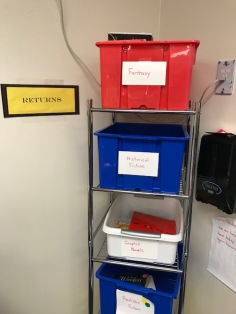Inspired by Susan Kennedy’s recent post (readingteachsu)
When I first arrived at this school, a newly minted reading specialist, the first directive was for me to collect all the books hiding in dusty cabinets and closets and create a centralized space where teachers could find books to use in their classrooms. I started over the summer, sorting books that smelled like the harsh cleansers they shared closet space with. I sorted through grade level sets of what used to be whole class novels. I un-packaged grimy baggies with cassette tapes and matching picture books. Eventually we had half a classroom full of shelves and books by level in sets of six. Behind the wall of bookshelves were nestled the reading tutors. When school began, we held a grand opening where we unveiled a complicated checkout system. That year some teachers used the books.
The book room has reflected the evolution of my own thinking about books and access across the years.
Due to shifting real estate demands within the building, our little book room was moved from the front hallway near my office to the far back hallway of the school. However, we did expand from half a classroom, to a full one. Conveniently, half the shelves were already on wheels and the new organization was, for the most part, just a more spread out version of the previous one. What did change was that I invited students to book shop in the new book room. It transitioned from a professional reading room and lending library, to a big extension of any classroom library. We added mismatched pillows and a few tables to give it a cozy touch. Almost all the books were still in sets of six to accommodate book clubs. The novels and NF were all organized by level. The picture books were organized (as they had been when I arrived) by some set of reading skills that no longer matched the curriculum. No one really used those, because no one knew where to look for a topic that would be of interest. More people started using the book room and its books. In fact, I discovered that far more kids than teachers utilized this resource. When teachers wanted books, they mostly found me in the hall or sent me an email that said, “We’re ready for all the such and such books. You can bring them down to our rooms this week.”
I’m delighted to get the right books into the right hands by any means…but I really wanted to create a space and a community of readers who would want to discover their own books. Over the past few years, I gradually tweaked the book room. Early on, I moved furniture to create a more appealing layout. I shifted leveled bins of books into genre sections. I even decided to scrap leveled bins altogether in the NF section because if I was looking for shark books, shouldn’t there just be a shark bin? As I read and reflected more on book levels, as I interacted with readers who came to look for books (who says, “I’m really feeling like a good O book right now!”?) I shifted chapter books out of leveled bins and into text sets like “Stories about school”, “Get the tissues ready”, or “Don’t read these in the dark!”
Remember I mentioned a complicated check out system year one? We’ve long since had a simple clipboard where readers can sign their own books in and out. Kids and adults can bring books to their classrooms, and even bring them home to read. Have we lost some books that never came back? Yes. Periodically I send out reminders for people to check their backpacks and under the couch. Some come back then, filling up the return bins near the door. When I’m in classrooms during the year, I skim classroom libraries and reclaim a handful of book room books that have set up residence there. But I’m less worried about losing some books than I am about losing readers! The books I can replace or replenish.


In the latest book room overhaul, I sorted those picture books onto the same shelves as their longer genre-mates so picture books and novels that address poverty are tucked side by side. Although there’s also a set of shelves for our favorite PB authors and illustrators, because sometimes you want to find a Cynthia Rylant or an Eve Bunting book. I even added corresponding NF bins alongside their historical fiction counterparts so readers can learn more about the time period they’re exploring .
.

I’m proud of the space, the collection, and the community of readers that I’ve been nurturing for seven years. Is the book room done evolving? Hah! I doubt it. As I read more middle grade books, as I build an increasingly diverse collection, as I learn more about my readers, I’ll continue trying to make our shared reading space one that meets everyone’s needs.
Next on my list, more kid-created displays for the walls and shelf-ends!

I love this part of my job!






Thank you for sharing your bookroom story and pictures! I’ve been feeling a nudge to do an overhaul, but I can’t quite face it yet, but I think the time is coming!
LikeLike
It’s amazing how I’m inspired to start a big overhaul like this just when other deadlines are looming. Best wishes for your project when you’re ready.
LikeLike
Now that is an impressive book room. I dream of having that
LikeLike
It has been a labor of love. I can’t say that I’ve read all the books…but I’ve managed about 75% of the fiction. Now, if I could only find some more shelves.
LikeLike